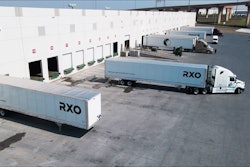
CCJ Innovators profiles carriers and fleets that have found innovative ways to overcome trucking’s challenges. If you know a carrier that has displayed innovation, contact CCJ Chief Editor Jason Cannon at [email protected] or 800-633-5953.
From ensuring compliance with regulations to reducing accidents and injuries, safety departments play a crucial role in trucking companies.
However, Andrew Winkler, general manager at Chief Carriers, noticed that drivers often view safety departments with apprehension over concern about potential reprimands for safety violations.
“Many times, it seems like in the industry, when you talk to drivers, they can be fearful of the safety department as a whole,” said Winkler. “We want to flip that; we want to catch people doing the right thing. And when we catch them doing the right things, we want to celebrate that a little bit."
The company started the Red Hat program, which identifies and celebrates drivers that embody the company’s safety values. Every driver is issued with a white hard hat, and when they’re “caught” practicing the company’s safety practices, they get issued a red one.
Winkler explained, “The idea was, anytime they’re out on one of our yards, in our terminals, if somebody – and it could be another driver or dispatcher – catches them in the act of wearing their safety gear and working safely around the truck when they’re tying loads down, that they would be eligible for a red hard hat.”
The Nebraska-based flatbed carrier – which currently runs 75 trucks and 225 flatbeds – started the program three years ago and has seen positive results in driver safety scores. Since its inception in 2022, the percentage of safety events has dropped by 52%, said Winkler.
To kick it up a notch, Chief also offered safety specialist positions at each of their terminals. “We have a lot of preloaded trailers from our shippers, and when drivers inspect their load and tie it down for the first time, sometimes the trailers weren’t loaded correctly,” said Winkler.
With a safety specialist onsite, Winkler said they can assist the driver and make sure they can answer safety procedure questions.
 Rich Svitak, safety specialist at Chief Carriers, presenting driver Edwin Pena with a red hat.Chief Carriers
Rich Svitak, safety specialist at Chief Carriers, presenting driver Edwin Pena with a red hat.Chief Carriers
Seeing the program’s results, Chief has also introduced Safety 360, another program to include financial incentives.
Winkler explained that twice a year, the safety department would propose a safety initiative, and if the driver already had his Red Hat and had been in the company for almost six months, he could qualify for the Safety 360 program.
Participants of the program are eligible to earn a raise. Winkler explained, "Drivers can earn an additional $.05 cents per mile the first year they join Safety 360 and an additional $.03 cents per mile each year thereafter. Top drivers who participate in Safety 360 and are dialed in to earning quarterly safety incentives have seen as much as a $.09 per mile increase their first year, which could easily translate to an additional $10,000 per year over a driver who is not actively participating in the safety programs."
The Safety 360 program involved more advanced securement training on certain types of loads. “We hold some large steel coils on our flatbeds, so that’s what they focus on,” said Winkler.
The carrier also uses a safety “score system” from the dash camera system to help identify risky driving behavior. The score is a rolling 30-day average of the entire fleet, Winkler explained, which looks at risk factors such as harsh driving, distracted driving, collision risk, traffic signs and signals, speed violations and company policy violations.
Currently, the fleet score is 93 out of 100. The drivers’ individual scores are directly tied to the Safety 360 program, quarterly performance incentives and annual reviews.
[Related: Cargo Transporters creates March Madness-style competition among drivers to improve safety]
Overcoming complacency
So far, Winkler said that the program has about 42 drivers – about 60% of the company's roll. Safety 360 has 34 members, about 48% of the team.
“If you find the right incentives for drivers, you know they’ll come forward,” said Winkler.
However, though the carrier has more drivers that are qualified for the programs, some haven’t come forward, either due to timing or other issues.
“One of the things that happens in probably any industry is when you have experienced, veteran people that have been working at the company for a long time, complacency can set in,” said Winkler. “That’s what we’re fighting.”
Though Chief wasn’t necessarily having a lot of accidents, what they noticed was they would have drivers working around the yard or trucks and they didn’t have a hard hat or the correct footwear on. “What we noticed is, it would seem to be more veteran drivers that were doing these things,” said Winkler.
Complacency can set in, he said, when seasoned drivers, who’ve never had an accident, start to believe it’s improbable. “That’s the kind of thing we want to tackle; we have to find a way to keep safety in front of these drivers at all times and just never let our guards down,” Winkler said.
To get such drivers on board, the carrier appeals to the drivers’ sense of pride. “We say, ‘You guys are the leaders, you’re the veterans, you are the ones that have worked here the longest and have the most experience with our company and hauling our type of freight, so we need you to be mentors and influencers to the new drivers and set an example.’”
So, is it a worthwhile safety initiative? Winkler said it certainly is, especially when you consider how an inexpensive investment on hard hats can make safety a core value in your organization and not just a priority or when it’s convenient.
For carriers hoping to implement similar initiatives, Winkler advised, “Fight driver complacency by constantly challenging them with safety activities that hone their professional skills – outdated videos and computer-based training is not a safety program. Then, develop policies, programs, incentives and rewards your entire staff can get behind to support the drivers.”
The CCJ Innovators program is brought to you by Bestpass, Chevron Delo, Comdata and Freightliner Trucks.










